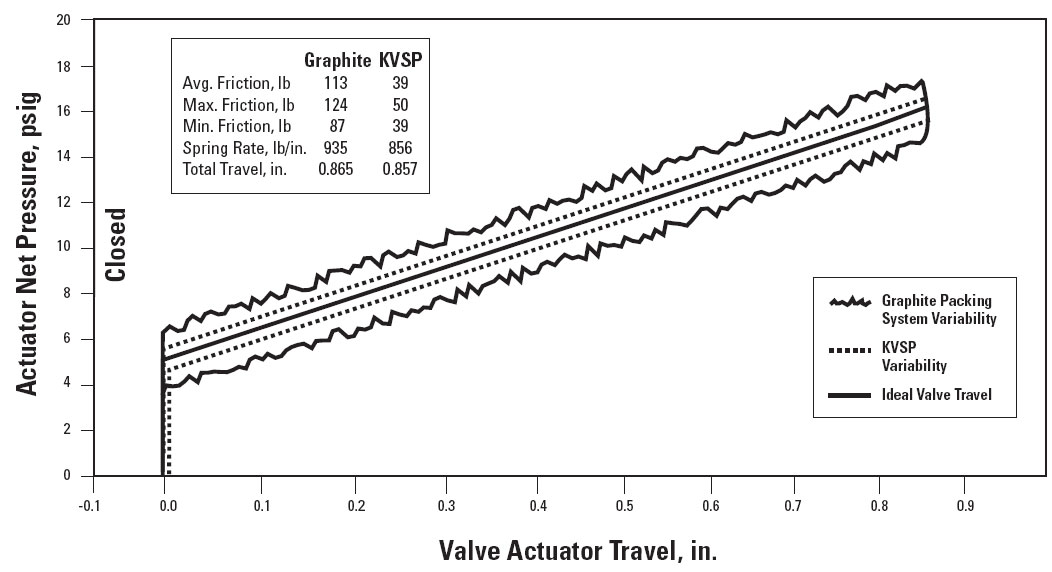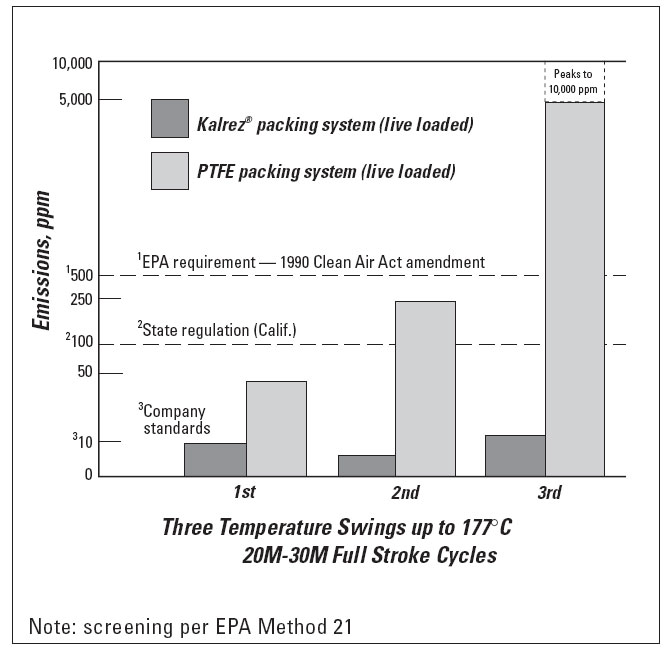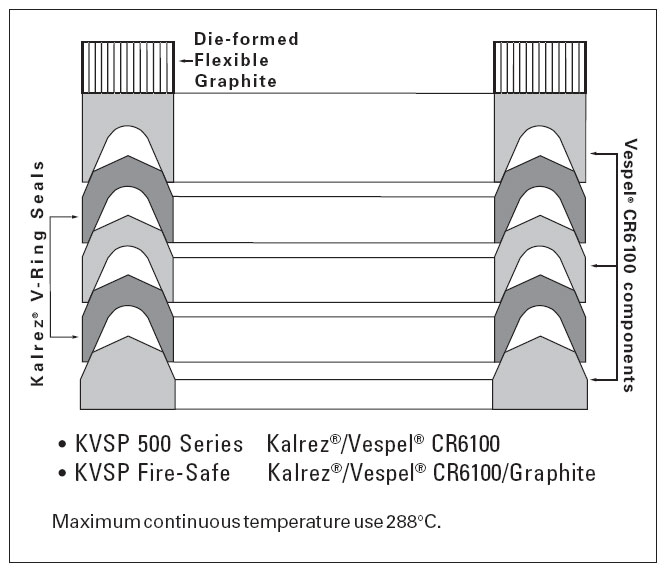Introduction
DuPont™ Kalrez® Valve Stem Packing (KVSP™) systems can help to significantly reduce fugitive emissions and improve process control through the innovative use of Kalrez® perfluoroelastomer parts combined with other proven packing materials. Graphite packing systems can meet fugitive emissions requirements but restrict valve movement, leading to inconsistent process control. Polytetrafluoroethylene (PTFE) has excellent process control response characteristics but cannot contain fugitive emissions when temperature cycling is involved in conjunction with operational cycling. Kalrez® packing systems overcome these deficiencies, as well as reducing leak rates to near-bellows performance.
Kalrez® is chemically an elastomeric PTFE derived from tetrafluoroethylene (TFE), the same base monomer. It provides a unique combination of chemical resistance and inertness like PTFE, but with a higher temperature service limit and no tendency to cold flow.
The chemical structure remains cross-linked and stable at high temperatures and does not move under load or deformation. Its resiliency and memory provide improved sealing for control valve stems. Using Kalrez® V-rings backed up with more rigid components of carbon fiber-reinforced PTFE (DuPont™ Vespel® CR-6100) has proven to be a major advancement in improving process control and reducing leakage to less than 1 ppm, or below the plant’s background level. Kalrez® perfluoroelastomer packing systems increase a valve’s ability to react quickly and smoothly to process changes (Figure 1). Kalrez® KVSP™ reduces process control variability to the control system’s capability, resulting in improvements to both yield and product quality on specification.
Figure 1. Kalrez® KVSP™ Improves Process Control Performance Over Existing Materials
Process Optimization by Reducing Variability
The control valve is the final control element in a process. Installing a sophisticated process control instrumentation system capable of achieving 0.5% or better variability should improve control variability, but many valves control to no better than 2–3%. Kalrez® KVSP™ systems move a control valve’s performance closer to the ideal valve through low stem friction and reduced deadband. Kalrez® KVSP™ improves the control valve’s response closer to the optimum performance capability of the control system.
Conventional Packings
PTFE square-braided and rope packings are the most commonly used packing elements for manual control valves (hand or automated on/off valves) in chemical plants, while automatic throttling control valves typically use more reliable and higher performance PTFE v-ring packing. PTFE packing is the standard material used in automatic control valves because of its broad chemical compatibility and excellent thermal stability. PTFE packing is used for temperatures up to, and occasionally exceeding, 204 °C, making it an ideal packing material for most chemical plants and select refinery applications.
Metal Bellows or Kalrez® KVSP™
The only option, until now, that could provide low leakage levels that approached 0 ppm has been metal bellows. Because bellows have thin metal membranes, they have pressure/temperature limitations and are subject to corrosion and cycle fatigue failures. Of course, in some extremely toxic or hazardous environments, bellows may still be the optimum choice. When combined with Kalrez® KVSP™ as the backup packing, it would offer the highest level of containment and safety.
Until now, conventional packing materials and packing systems have not been able to provide the lower leakage rates provided by the metal bellows. The DuPont™ Kalrez® packing systems offer a viable option in both absolute fugitive emission reduction levels and long-term performance.
The Kalrez® KVSP™ systems provide performance that approaches zero leakage. This was verified using a Foxboro flame ionization leak detection device, described by the EPA in Method 21, typically used for monitoring fugitive emission leakage of hydrocarbon-based volatile organic compounds (VOCs). The Kalrez® KVSP™ packing systems have consistently performed to the plant’s background level, and approached the fugitive emission performance of metal bellows technology. In addition, the Kalrez® KVSP™ systems have been tested to over 100,000 and 250,000 cycles, and have successfully performed in the field to over 500,000 cycles.
Metal fatigue and possible catastrophic failure are the realities of using metal bellows. Metal bellows made from special metal alloys can almost completely eliminate leakage, but the cost is inherently more expensive, typically 5 to 7 times more than Kalrez® KVSP™.
Assembly and Component Material Selection
DuPont™ Vespel® CR-6100 is a non-creep (carbon fiber filled) PFA that provides stability and minimal creep for higher temperature applications, continuous service to 288 °C. The addition of a flexible graphite ring has passed the API 607 3rd Edition Fire Test and the equivalent British Standard, BS 6755
Unique V-Packing Design
The design objective for packing should be to maximize containment while improving process control. The surface and contact area for the elastomeric chevron sealing ring and design of the support elements are important. Too little elastomeric sealing surface jeopardizes the system’s sealing integrity, while too much increases the system’s friction and ability to react to process input changes.
A perfluoroelastomer packing increases the valve’s ability to react quickly to process changes, resulting in improvements to both yield and product quality. This can be easily verified by running diagnostic tests.



